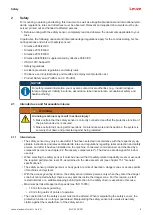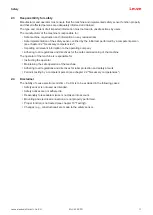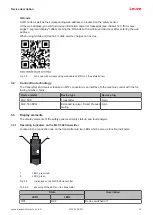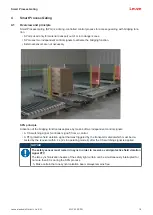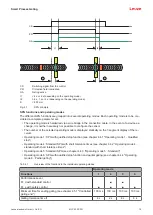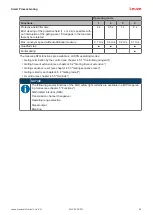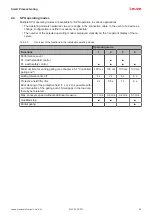
Safety
Leuze electronic GmbH + Co. KG
MLC 530 SPG
9
• The improper repair of the protective device may result in loss of the protective function. Make no re-
pairs to the device components.
• The safety sensor must be inspected regularly by a competent person to ensure proper integration and
mounting (see chapter 2.2 "Necessary competencies").
• The safety sensor must be exchanged after a maximum of 20 years. Repairs or the exchange of wear
parts do not extend the mission time.
SPG can only be used if the following is known to the control:
• The times at which the position of the transport material is no more than 200 mm in front of and no
more than 200 mm after the electro-sensitive protective equipment (ESPE) are known to the control. In
some cases, additional measures may be necessary for position determination, e.g., trigger, sensor,
etc.
• If additional measures are necessary for position determination, they must not come from a source that
is easily tampered with.
If necessary, use the evaluation of additional information, e.g., belt movement signal.
WARNING
Reduce conveyor speed!
If the time at which the object exits the protective field is not known to the control, the conveyor
speed must be reduced to the maximum value that is permissible for automatic gating end:
Operating modes 1, 6: 0.1 m/s
Operating mode 4: 0.4 m/s
Operating mode 5: 0.2 m/s
2.1.2
Foreseeable misuse
Any use other than that defined under the “Approved purpose” or which goes beyond that use is consid-
ered improper use.
In principle, the safety sensor is
not
suitable as a protective device for use in the following cases:
• Danger posed by ejected objects or the spraying of hot or hazardous liquids from within the danger
zone
• Applications in explosive or easily flammable atmospheres
WARNING
Severe injuries when riding along on or next to the conveyor belt!
Ä
Make certain that it is not possible for persons to enter or to ride along on and next to the
conveyor belt or transport material during SPG operation.
2.2
Necessary competencies
The safety sensor may only be configured, installed, connected, commissioned, serviced and tested in its
respective application by persons who are suitably qualified for the given task. General prerequisites for
suitably qualified persons:
• They have a suitable technical education.
• They are familiar with the relevant parts of the operating instructions for the safety sensor and the oper-
ating instructions for the machine.
Task-specific minimum requirements for competent persons:
Configuration
Specialist knowledge and experience in the selection and use of protective devices on machines as well as
the application of technical rules and the locally valid regulations on labor protection, safety at work and
safety technology.
Specialist knowledge in programming safety-related controls SRASW acc. to EN ISO 13849-1.








